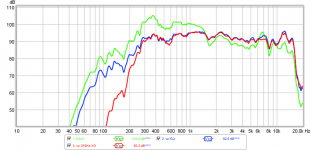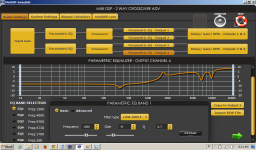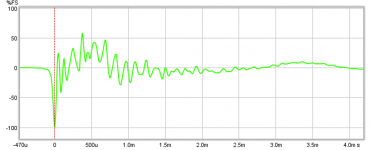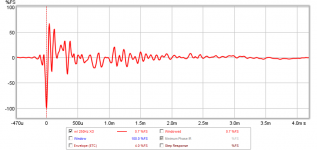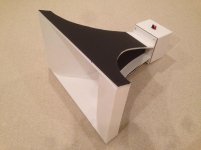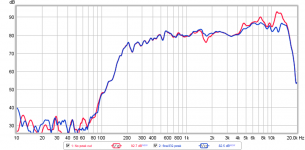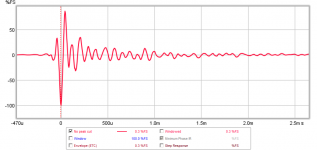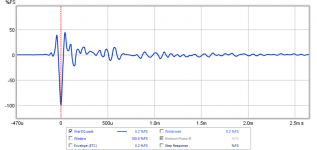Everything is relative, low noise compared to mine 😀. Take a look: http://www.diyaudio.com/forums/subwoofers/258706-study-dipole-cardioid-bass-horn-30.html#post4037492
That does look like mic/preamp noise that is overwhelming your signal. It has no peaks so indicates it is broadband noise. Do you have a lot of air conditioning fan noise going on?
That does look like mic/preamp noise that is overwhelming your signal. It has no peaks so indicates it is broadband noise. Do you have a lot of air conditioning fan noise going on?
No air conditioning, it's just the DC phantom supply/mic pre amp having noise issues (Focusrite Scarlett 2i2) 🙁. That's also why the THD/all harmonics always (especially at low spl) rise in the LF in REW's "sweep view" (since harmonics cannot go lower than the noise floor). In spectrum view one can take the noise floor into account better.
Last edited:
Raw response with CLD applied and with EQ
Legis,
Here is the raw response of the horn with the CLD in place. There is a sloped HF fall-off, and the low frequency knee is now around 300 Hz. I am able to integrate with the sub at a XO of 250Hz (-24dB/oct):
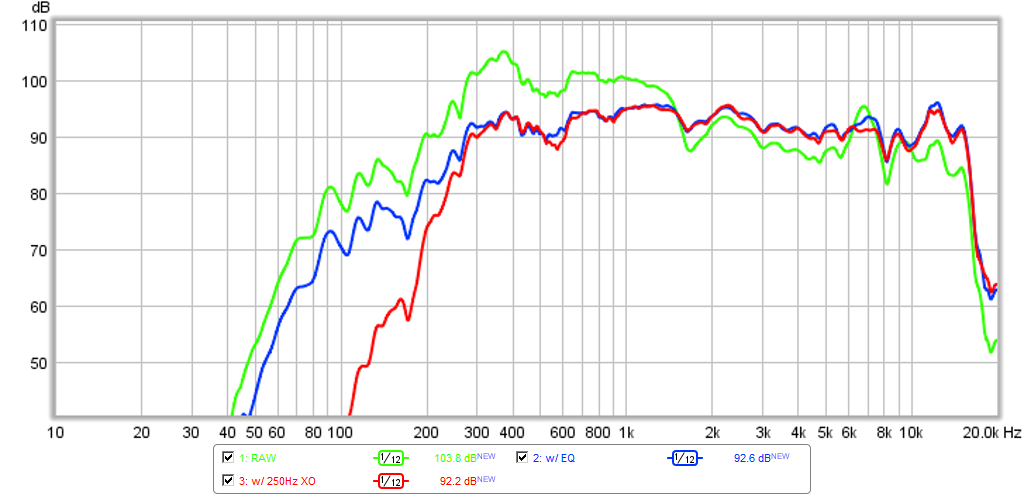
Here is the EQ that is now used:
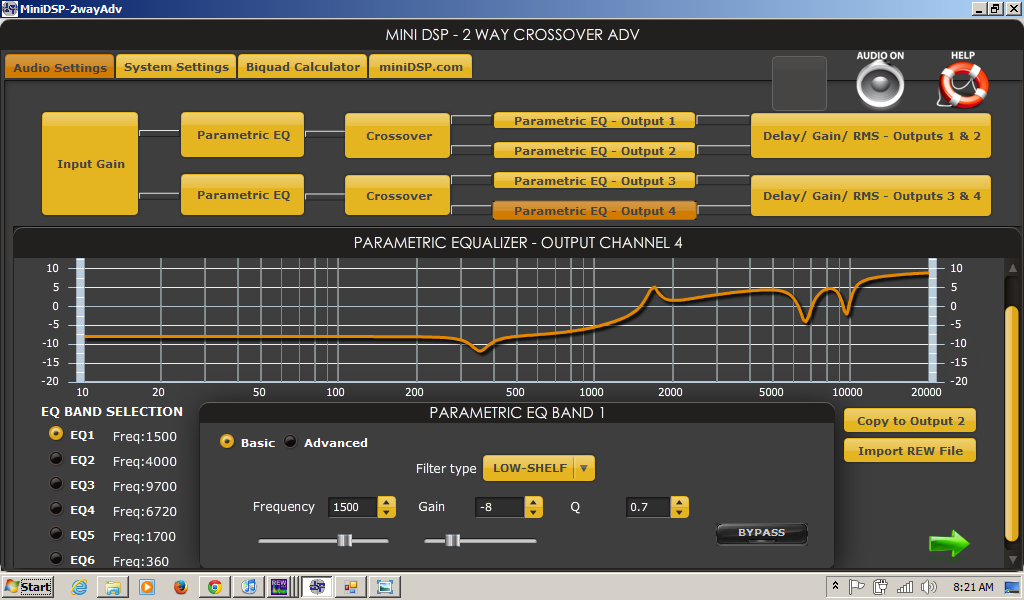
The main settings were a high shelf at 4kHz of 9dB and Q=0.4; low shelf at 2.5kHz -8dB, Q-0.7; peak cuts at 360Hz, 6720Hz, 9700Hz; and the peak boost at 1.7kHz of 6dB and Q=7 to help smooth the throat cancellation (i.e., a DSP "phase plug" 😀) Yeah, I know it's bad to do a postive peak boost in 500Hz to 5kHz range but I will listen to it this way for a while and then remove it and see if I can tell a difference.
Legis,
Here is the raw response of the horn with the CLD in place. There is a sloped HF fall-off, and the low frequency knee is now around 300 Hz. I am able to integrate with the sub at a XO of 250Hz (-24dB/oct):
Here is the EQ that is now used:
The main settings were a high shelf at 4kHz of 9dB and Q=0.4; low shelf at 2.5kHz -8dB, Q-0.7; peak cuts at 360Hz, 6720Hz, 9700Hz; and the peak boost at 1.7kHz of 6dB and Q=7 to help smooth the throat cancellation (i.e., a DSP "phase plug" 😀) Yeah, I know it's bad to do a postive peak boost in 500Hz to 5kHz range but I will listen to it this way for a while and then remove it and see if I can tell a difference.
Attachments
If your preamp has a switch to turn off the phantom power, you could try relative simple schematic attached 2 x 9V battery phantom power. The schematic is clone of AKG B18 battery phantom power. For less phase wrap in low increase value the two 100uF caps, and use preferred cap brand for this signal AC coupling. This circuit could be placed in microphone end of cable if environment is especially noisy.No air conditioning, it's just the DC phantom supply/mic pre amp having noise issues (Focusrite Scarlett 2i2) 🙁. That's also why the THD/all harmonics always (especially at low spl) rise in the LF in REW's "sweep view" (since harmonics cannot go lower than the noise floor). In spectrum view one can take the noise floor into account better.
Attachments
Last edited:
I just checked the SPL levels measured and the drive voltage and it matches the predicted sensitivity very well. With a 1.6 v rms 1kHz sine wave I measured 98dB at 2m is same as 104dB at 1m, 2.83v rms is same as 3x more power or about another ~4.5dB for 108dB at 1m and 2.83v. I can see why low power tube amps like a horn setup. Anyhow, my ears really should have had some protection for some of these tests... 🙂
108dB at 1m and 2.83v.
 WHAT? That might be worth the price, was that the 4 or 8 ohm?
WHAT? That might be worth the price, was that the 4 or 8 ohm?When you get a chance, another sweep without EQ so we can see the dampening improvements.
So you are sourcing better materials to build some NICE ones next, right?

Jell-coat and casting resin, 3D SLA print, paper,carbon...
WHAT? That might be worth the price, was that the 4 or 8 ohm?
When you get a chance, another sweep without EQ so we can see the dampening improvements.
So you are sourcing better materials to build some NICE ones next, right?
Jell-coat and casting resin, 3D SLA print, paper,carbon...
See the green trace in post 143 above - that is raw after CLD was applied. Foam core is all I build for now with no workshop. This thing would cost a fortune in 3d print. I am actually really happy with how the foam core CLD worked out. Having the exact 2d cad generated patten for the curved panel was key - the horn just falls into place. The horn is still light and manageable to hold, move, mount, etc. This is the 8ohm version of the driver. I don't think it is uncommon for FLH's to be 100dB plus sensitive. It focuses all the energy that would have gone out over 4pi steradian into an approximately 60 to 80 deg cone. But, yes, it is loud when you are in front of it, even 4m back. I had to re calibrate in my mind where to set the volume knob or hurt my ears. 😀
IR before and after EQ
Someone asked what the effect of the EQ was on the impulse response (IR). Here it is (after CLD) raw - no EQ:
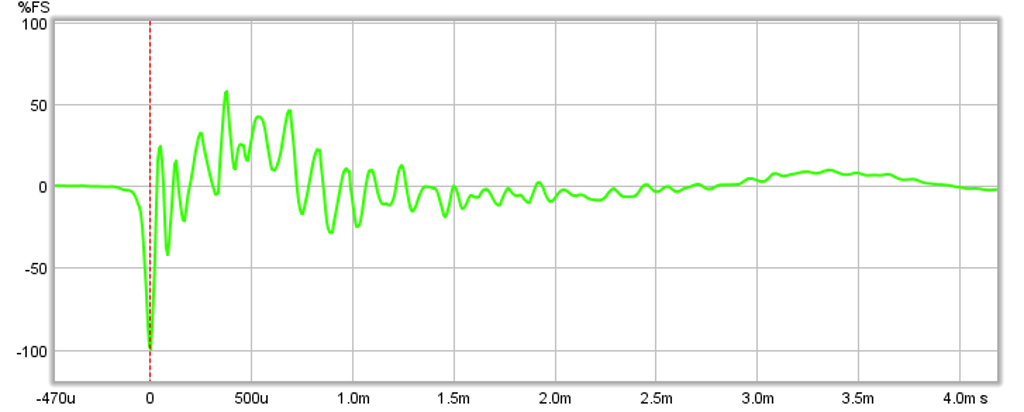
Here is the impulse response after the EQ:
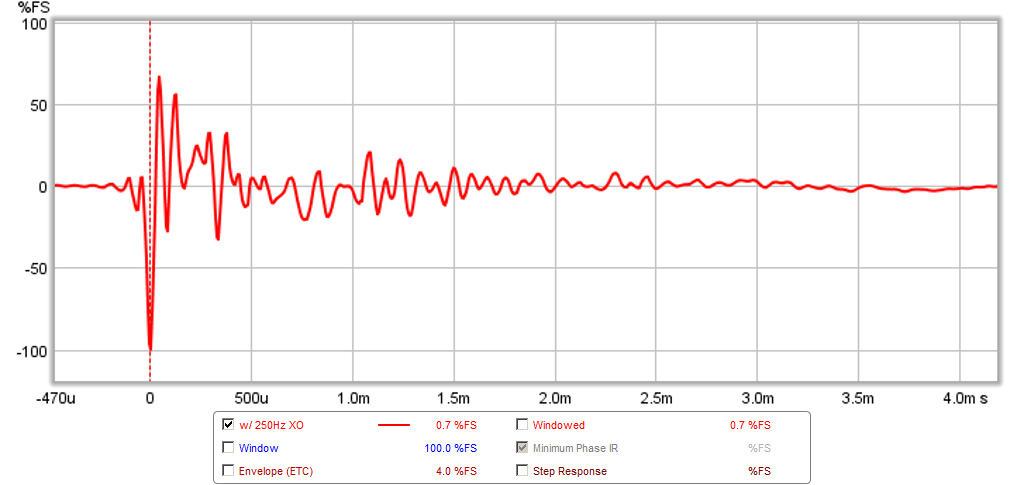
I believe the 8-9kHz oscillation after the main pulse may be from the cone breakup as it was present in the OB and IB (Nautaloss), but not as large and with shorter duration.
Here is a final photo of the completed horn with the CLD on all walls. It has a very dull thud sound when you tap on the panels, whereas before it was almost drum-head like.
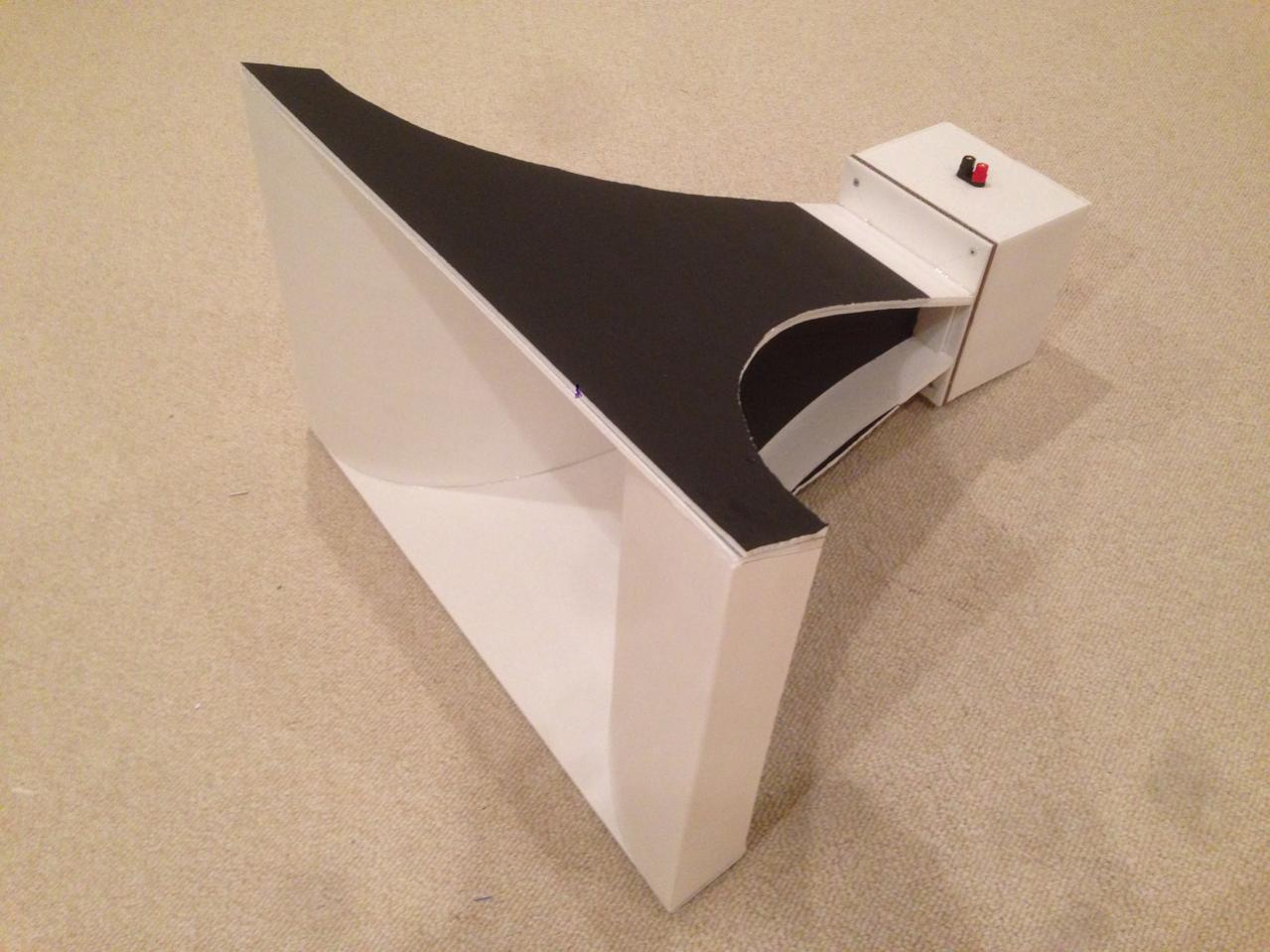
Someone asked what the effect of the EQ was on the impulse response (IR). Here it is (after CLD) raw - no EQ:
Here is the impulse response after the EQ:
I believe the 8-9kHz oscillation after the main pulse may be from the cone breakup as it was present in the OB and IB (Nautaloss), but not as large and with shorter duration.
Here is a final photo of the completed horn with the CLD on all walls. It has a very dull thud sound when you tap on the panels, whereas before it was almost drum-head like.

Attachments
Last edited:
is there any noticeable added noise or loss of transparency from the mini DSP box?
No, not to my ears and mic. I actually made some measurements in another thread (Cheap and FAST OB, Literally) and could not detect any difference. The miniDSP has a version that uses SPDIF outputs and external high quality DAC's. Some people say that they can hear a difference.
If you have time and motivation to keep hot-rodding it, you may try adding round-overs to the edges. 😉
Yeah, XRKs done such a great job documenting his tractrix, it'd be really cool to see what effect round-overs have on the top, bottom and even the sides with regards to previous measures...? I've seen P.Batemen take measurements with round-overs but it wasn't the only change that was made. The quantitative improvement remains a mystery.
if there's an assembled version "cheap" with SPDIF out (?) then I may give a go
Yes, it is called nanoDIGI. They cost more and require additional DACs. 2x4 an 2x8 ch varieties. Before getting that just get basic version with built in DACs for $80 and $10 for 2x4 plugin. Sounds pretty good and you can play with XO and EQ for cheap.
If you have time and motivation to keep hot-rodding it, you may try adding round-overs to the edges. 😉
I just switched back to the Nautaloss rig. The tractrix has no motor and sits on jack stands in the garage now. Hot rodding will have to wait. 🙂
I imagine round overs affect the wavefront propagation and reduce impedance change of an abrupt end to the mouth lip. This may smooth response. I think more substantial improvements can be had with a round to square duct transition at the throat. Something very easy to make in foam core. A centerbody phase plug could also be added at that point. It is surprising how well it worked with no phase plug - just a large square throat. I did use a razor to cut little 45 deg chamfer on the edge of the throat. Not sure if that had any effect. Before dismantling the horn I did try on mod as suggested by Edgar: add a 0.5in cavity with a gap in the throat as a spacer between driver and horn and fill with foam for a Helmholtz resonator to cut the peaks due to breakup and throat phase cancellation. It worked on reducing one peak and exaggerating another. Maybe multiple lengths of cavities are needed?
Last edited:
Legis,
Here is the raw response of the horn with the CLD in place. There is a sloped HF fall-off, and the low frequency knee is now around 300 Hz. I am able to integrate with the sub at a XO of 250Hz (-24dB/oct):

Here is the EQ that is now used:

The main settings were a high shelf at 4kHz of 9dB and Q=0.4; low shelf at 2.5kHz -8dB, Q-0.7; peak cuts at 360Hz, 6720Hz, 9700Hz; and the peak boost at 1.7kHz of 6dB and Q=7 to help smooth the throat cancellation (i.e., a DSP "phase plug" 😀) Yeah, I know it's bad to do a postive peak boost in 500Hz to 5kHz range but I will listen to it this way for a while and then remove it and see if I can tell a difference.
I see you need so 8 dB of extra power to get the higher frequenties right, this tells me that the do fall off 8 dB there.
regards
kees
Source of 1.7khz mystery dip solved.
I put the driver back into the Nautaloss (low coloration cabinet) and measured the response of the driver at close range 1 ft away. Very interesting sharp dip at exactly 1.68kHz is evident. Dip is more like a cliff on left side and is -4dB deep. This dip is not visible at 1m or listening position. At a horn throat it just gets amplified and the spatial recombination of an open face driver does not happen.
I am also studying carefully the application of strategic notches to remove cone breakup to clean up the IR. It is working and I can almost completely remove the after ringing which appears to be dominated by the 12kHz broad peak. I will post results later but this is an interesting development because I believe it vindicates the tractrix horn throat as being source of 1.7kHz dip. I believe application of EQ peak boost here of 4dB is ok given that we are fixing a driver's intrinsic dip at close range vs a horn problem.
I put the driver back into the Nautaloss (low coloration cabinet) and measured the response of the driver at close range 1 ft away. Very interesting sharp dip at exactly 1.68kHz is evident. Dip is more like a cliff on left side and is -4dB deep. This dip is not visible at 1m or listening position. At a horn throat it just gets amplified and the spatial recombination of an open face driver does not happen.
I am also studying carefully the application of strategic notches to remove cone breakup to clean up the IR. It is working and I can almost completely remove the after ringing which appears to be dominated by the 12kHz broad peak. I will post results later but this is an interesting development because I believe it vindicates the tractrix horn throat as being source of 1.7kHz dip. I believe application of EQ peak boost here of 4dB is ok given that we are fixing a driver's intrinsic dip at close range vs a horn problem.
Last edited:
Effect of Notch Filters for Breakup Modes on IR
Here is the 5MR450NDY mounted in the Nautaloss and measured at close distance (12 in) away. You can see the 1.7kHz dip and the cone break up peaks in the 6kz to 12kHz range. The red trace is the response before the peak notches and blue is after.
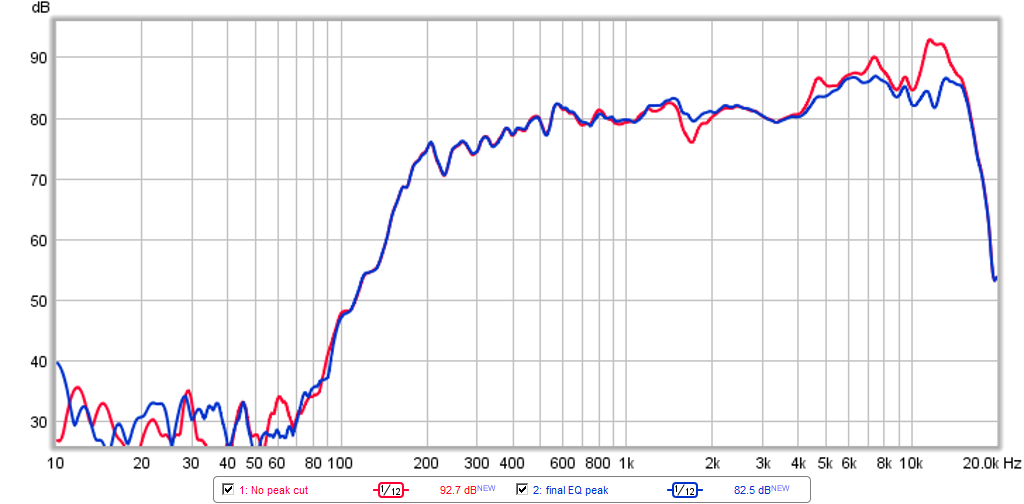
Here is the corresponding IR for the case without the notches, note the ringing - predominantly seen with 12 cycles in 1ms or 12 kHz. So I applied the 12kHz notch first and that yielded a big improvement.
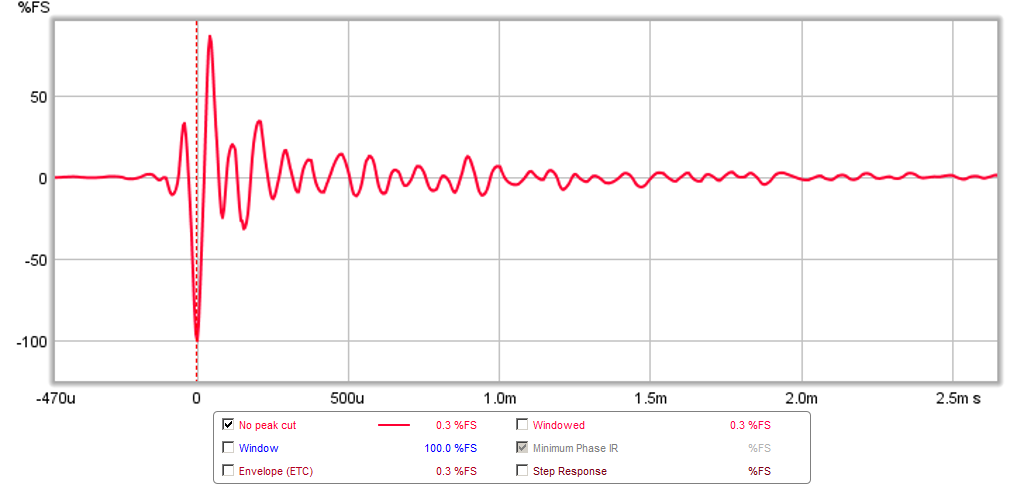
Here is the IR with the notches applied and also a boost at 1.7kHz to fix the dip caused by the driver that shows up in the tractrix. Much cleaner now.
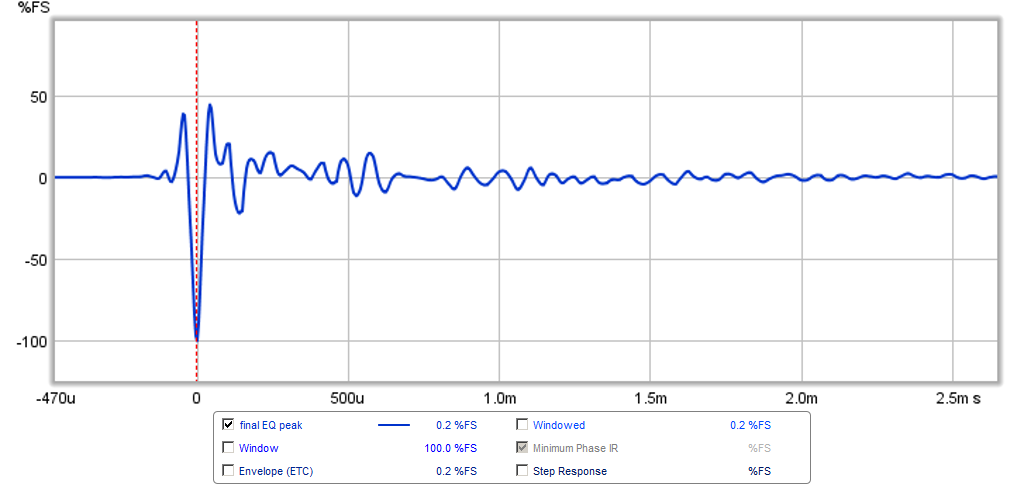
Cymbals and high hats sound better now. 🙂
Here is the 5MR450NDY mounted in the Nautaloss and measured at close distance (12 in) away. You can see the 1.7kHz dip and the cone break up peaks in the 6kz to 12kHz range. The red trace is the response before the peak notches and blue is after.
Here is the corresponding IR for the case without the notches, note the ringing - predominantly seen with 12 cycles in 1ms or 12 kHz. So I applied the 12kHz notch first and that yielded a big improvement.
Here is the IR with the notches applied and also a boost at 1.7kHz to fix the dip caused by the driver that shows up in the tractrix. Much cleaner now.
Cymbals and high hats sound better now. 🙂
Attachments
 ... and a repeat
... and a repeat  ...
...A minimum phase system sealed box gives 180º phase wrap from DC to HF, is the wrap same when a horn in front.
and a repeat
Did you ask this before and I never replied? I will see if I have any phase data from near the mouth as you will get phase wraps when far away due to pathlength difference.
- Home
- Loudspeakers
- Full Range
- PRV 5MR450-NDY for FAST/WAW applications
